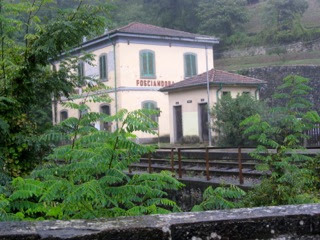Trains, sheep and other diversions
 |
| The station halt at Fosciandora |
En route to see the
structural wonders of Pisa (see Towering Genius), we find the level crossing closed at the
foot of the mountain and the red light flashing. We are about to witness another pride of
Italian engineering, the railway system. The station at Fosciandora is on the Pisa to Aulla line, one of
the early beneficiaries of Benito Mussolini's programme of efficient rail
networks throughout Italy in the 1930s. (Although it is said that the widely trumpeted reputation of Italian
railways for punctuality reflected more the fear of admitting
failure to Il Duce than the reality.)
Aulla is a town in the mountains not far
from Carrarra, at the strategic junction of two rivers, and was virtually
destroyed during the Second World War, as this part of Italy was a stronghold
of resistance by partisans against the Nazis and the Fascist Government. Today the station at Fosciandora does look rather like an abandoned set
from a film featuring resistance fighters, purloined artworks and a guest performance by Donald Sutherland, but despite appearances, it is fully
operational.
 |
| Passing through |
In fact it is possible to travel by train from the mountain halt of Fosciandora to a station in the UK within the day, or on a smaller scale, make a trip to the centre of Pisa without worrying about where to park. Admittedly you have to read the timetable
with care to ensure that you are on one of the trains that stops, rather than
hurtles straight through, rattling the glasses and crockery in Claudio’s bar and restaurant, but still a useful alternative mode of travel. Next year, perhaps...
 |
| The splendour of the Duomo in Pisa |
This proves to be easier said than done. After driving several miles through the nature reserve, part of which appears to be occupied by a military camp, we pull over in the shade of a line of trees to take a birthday greetings telephone call from son in Pakistan. After exchanging just a few words, the conversation is interrupted a loud blast on a horn. The driver of a very large garbage trucks gesticulates for us to move out of the way. We realise that in all the vast acreage of the reserve we have chosen to pull over in front of a collection of large waste bins, hidden in the shade of the trees.
We finish the transcontinental conversation and decide to find our way out of the reserve and head back to Fosciandora for dinner. As we drive through increasingly smart clusters of stylish houses towards a road that should take us to the motorway, there suddenly appears a cluster of dark, rippling shapes, filling the carriageway. A man in a grey shirt materialises, wielding a stick and with a black dog weaving around and in front of him. It is a shepherd, in the middle of a smart Pisan suburb, moving his flock to a new pasture.
The dust settles, we find the motorway and drive back in time for a shower and change before dinner at Claudio's place. No fresh wild mushrooms yet, he says, because of the hot, dry weather, but there is lamb is on the menu this evening.


No comments:
Post a Comment